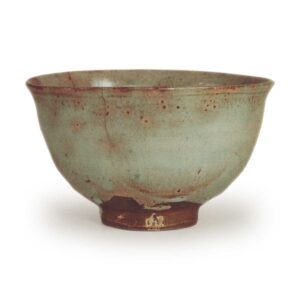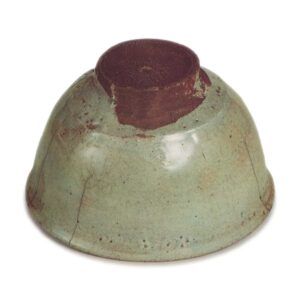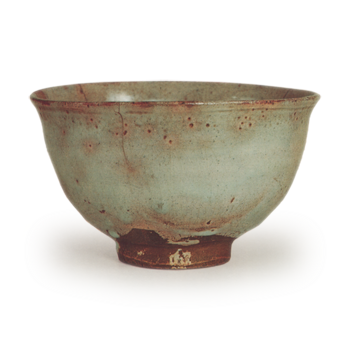

Height: 7.6-7.8cm
Diameter: 12.2-12.8cm
Foot diameter: 5.0cm
Height: 1.0cm
The name “tamago-te” is not very old, like the classification of aoi-do and ko-ido.
The only writing we have for this type of tea bowl from around the time of the Enshu period is “Kora”, so it is thought that the name “Tamago-te” came about during the time of Matsudaira Fumai. Kobori Jūzaemon also wrote “Kora-bukaki” for the thin persimmon included in this volume, and the tea bowl in Enshu’s possession is not called “Tamago-te”, but is written as “Kora-iro-kae” by Enshu. However, the fact that the inscription on the tea bowl “Shūfū” in the “Unshū Meibutsu Ki” is written by Fumai in the inscription “Shūfū Tamagote” shows that this type of tea bowl came to be called “Tamagote” in particular in the Fumai period.
There are various types of egg-handled tea bowls, such as the “Usugaki” type, which has a glaze that looks just like an egg shell, and the “Akikaze” type, which has a glaze with a grayish-blue hue, and all of them have a characteristic glaze that melts well and has a strong sheen.
The clay also comes in a variety of colors, including brownish ones with a little iron content and gray ones, but the clay used for the tea bowls and “Akikaze” (Autumn Wind) pieces with a grayish-blue glaze is usually a brownish clay with a little iron content.
The general shape is thin, with a distinct bulge around the waist and a tight finish around the rim, but the rim is characterized by its slightly turned-up edge. There are no eye marks on the inside, and there is a small, deep dent in the center, which is similar to the design of the Kuma River tea bowl.
The grayish-blue glaze that covers the entire surface is partially vitreous, and it also changes from a strongly blue area to a slightly yellowish area in a roughly half-and-half pattern. The glaze on the inside is thicker than the outside, so the craquelure is rough. Furthermore, there are scattered perforations around the rim on the outside, and the appearance is softened by the appearance of light red speckles. The foot is thinly scraped, and the clay surface inside the foot shows the creases seen in Karatsu tea bowls. From the foot to the waist, “deep cracks in the mountain” are also present, giving the appearance of a simple scene.
It is thought that the overall structure is extremely thin, and it is thought that it came to be called “tamago-te” (egg hand) because it is thin like an egg shell, and it is thought that its elegant taste was appreciated as a thin tea bowl from ancient times. This tea bowl is one of the most well-balanced and elegant works of the genre.
The inscription on the inside of the lid, “Chawan Koryo”, is the work of Kobori Enshu Masayuki, also known as Sokei. It is listed in the published book “Enshu Zocho”, and was passed down from the Kobori family to the Fujita family.



